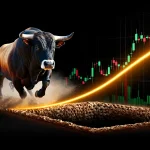Market Polarization and Uncertainty: The Perfect Recipe for Mass Losses!
Introduction
In today’s frenetic financial landscape, the market is awash in polarizing narratives that often lead investors astray. Market polarization—where investors split into extreme camps—creates a breeding ground for mass folly and ill-considered investment decisions. Fueled by the bandwagon effect and a host of cognitive biases, this dynamic environment forces many to follow trends blindly rather than make rational, independent decisions. Today, we will explore how market polarization undermines sound investment strategies, examine psychological traps such as the bandwagon effect and cognitive biases, and offer real-world examples that illustrate the perilous consequences of this phenomenon.
The Nature of Market Polarization
Market polarization occurs when investors become entrenched in either bullish or bearish views to the point where emotional responses override rational analysis. In such a climate, every piece of news is interpreted through the lens of these extremes. Sensational headlines and emotionally charged narratives often drive this polarization. Rather than considering a balanced view of market fundamentals, many investors latch onto a single, polarizing opinion.
For instance, during the dot-com bubble of the late 1990s, extreme bullish sentiment on technology stocks created a market where investors disregarded valuation metrics in favor of fervent optimism. Prices soared based on hype rather than on sound fundamentals, and many individuals ended up investing in overvalued companies simply because “everyone else was doing it.” This is a classic example of the bandwagon effect, where market participants follow the crowd, ignoring the inherent risks.
The Bandwagon Effect and Its Impact
The bandwagon effect is a powerful psychological phenomenon where individuals adopt a belief or take action because they see others doing the same. In the stock market, this often translates into a herd mentality where investors buy into hot sectors or stocks simply because the prevailing sentiment is positive. This phenomenon can drive asset prices to unsustainable levels and often sets the stage for dramatic corrections when reality catches up with inflated expectations.
Consider the cryptocurrency market. During the peak of Bitcoin’s rise, many inexperienced investors jumped on the bandwagon, swayed by the promise of exponential returns. Social media and online forums amplified the bullish sentiment, creating an echo chamber that drowned out rational warnings about volatility and regulatory risks. The resulting frenzy drove prices far beyond intrinsic value, followed by sharp corrections that left many investors with significant losses.
Cognitive Biases in a Polarized Market
Beyond the bandwagon effect, several cognitive biases further exacerbate the pitfalls of market polarization. These biases skew investor perception and decision-making, leading to impulsive investment behaviours.
- Confirmation Bias: Investors tend to seek out information that confirms their existing beliefs and ignore contradictory data. For example, during a bull market, a polarized investor might focus solely on positive news and analyst upgrades, dismissing any reports of potential market risks or downturns. This selective attention creates a false sense of security, reinforcing over-optimistic market positions.
- Anchoring Bias: This bias occurs when investors fixate on a specific reference point—such as a past stock price—and fail to adjust their expectations in light of new information. In a polarized environment, if investors anchor their expectations to a peak price reached during euphoric times, they might irrationally hold on to overvalued stocks, expecting them to return to that level, even when fundamentals suggest otherwise.
- Recency Bias: Recency bias leads investors to give undue weight to recent events or trends, ignoring long-term historical data. During periods of market polarization, this bias can result in overreactions. For instance, following a series of short-term gains in a booming market, investors may assume that the upward trend will continue indefinitely, disregarding cyclical patterns and the possibility of a reversal.
Real-World Examples of Polarization-Induced Folly
Historical market events prove polarization and cognitive biases can lead to irrational investment decisions.
The Dot-Com Bubble:
During the late 1990s, the stock market became polarized by extreme optimism about the potential of Internet companies. Investors caught up in the bandwagon effect poured money into tech stocks with little regard for traditional valuation metrics. Confirmation bias led many to ignore warning signs, while recency bias reinforced the belief that the market’s rapid rise would continue unabated. When the bubble burst in the early 2000s, countless investors were left holding worthless stocks, illustrating how polarized thinking can culminate in mass financial folly.
The Housing Bubble and 2008 Financial Crisis:
Another striking example is the housing bubble that led to the 2008 financial crisis. In the years preceding the crisis, polarized optimism about rising real estate prices drove investors to take on excessive risk. The bandwagon effect and recency bias made it easy for individual and institutional investors to ignore the underlying credit risks. When the bubble finally burst, the fallout was catastrophic—home values plummeted, and the ensuing financial crisis sent shockwaves through global markets. This crisis underscored how market polarization can breed systemic risk and ill-conceived investment decisions.
Cryptocurrency Mania:
More recently, the cryptocurrency craze has highlighted the dangers of polarization in modern markets. As Bitcoin and other digital currencies gained popularity, investors were swept up in a wave of enthusiasm often bordering on irrational exuberance. The bandwagon effect was amplified by social media and online forums, where success stories were celebrated and cautionary voices were drowned out. Cognitive biases like confirmation bias ensured that many investors continued to buy in even when red flags emerged—such as regulatory uncertainties or market volatility—leading to dramatic price swings and significant losses when corrections occurred.
The Role of Media in Fueling Polarization
The media plays a crucial role in shaping market sentiment, often amplifying polarized views. Sensational headlines and opinion pieces are designed to capture attention by eliciting strong emotional responses. This media environment can skew public perception, driving investors toward extreme positions. For example, during periods of economic uncertainty, news outlets frequently focus on worst-case scenarios—rising national debt, looming recessions, or geopolitical tensions—ignoring the broader economic context. This selective reporting reinforces a polarized mindset, where investors become fixated on fear or greed rather than a balanced analysis of the facts.
The Consequences of Ill-Thought-Out Investment Decisions
When market polarization drives investment decisions, the results are often disastrous. Investors who succumb to the herd mentality are more likely to make impulsive, short-sighted decisions that ignore long-term fundamentals. These decisions not only jeopardize individual portfolios but can also contribute to broader market instability. For instance, asset bubbles are formed when a critical mass of investors buys into a fad without understanding its underlying value. These bubbles eventually burst, leading to widespread losses and undermining investor confidence.
Moreover, the fallout from such events can have lasting economic consequences. The 2008 financial crisis, triggered partly by the irrational exuberance and polarization in the housing market, led to a global recession that affected millions worldwide. In contrast, investors who maintain a calm, unpolarized approach—relying on careful analysis and disciplined strategies—are better positioned to weather market downturns and capitalize on opportunities when prices eventually correct.
Strategies to Combat Polarization and Cognitive Biases
Given the inherent risks of market polarization, investors must adopt strategies to mitigate the influence of cognitive biases and the bandwagon effect. The first step is to cultivate an unpolarized, balanced mindset. This involves recognizing that extreme views, whether optimistic or pessimistic, are often driven by emotion rather than rational analysis. By actively questioning prevailing narratives and seeking out diverse sources of information, investors can develop a more nuanced perspective on market trends.
1. Embrace Diversification and Long-Term Thinking:
A well-diversified portfolio that spans multiple asset classes can help reduce the impact of any single polarized trend. By focusing on long-term value rather than short-term market fads, investors can avoid the pitfalls of overreacting to sensational news. For example, during the dot-com bubble, those who maintained diversified portfolios with exposure to traditional industries fared far better than those who invested exclusively in tech stocks.
2. Implement Systematic Investment Approaches:
Systematic strategies, such as dollar-cost averaging and disciplined rebalancing, can help remove emotional biases from decision-making. Technical analysis tools and trend indicators provide objective data that can signal optimal entry and exit points, assisting investors in avoiding the trap of buying high and selling low. These approaches are particularly useful in a polarized market, where emotion can otherwise dominate investment decisions.
3. Educate Yourself on Behavioral Finance:
A deep understanding of behavioural finance is crucial for recognizing and countering cognitive biases. Books like Your Money and Your Brain by Jason Zweig and Animal Spirits by George A. Akerlof and Robert J. Shiller offer valuable insights into how psychological factors influence investment decisions. By studying these works, investors can learn to identify biases such as confirmation bias, anchoring, and recency bias, and take steps to mitigate their impact.
4. Seek Professional Advice:
Consulting with a financial advisor who emphasizes a rational, disciplined approach to investing can provide an external perspective that counters the influence of market polarization. An experienced advisor can help you develop a robust investment plan, grounded in fundamentals rather than emotional reactions, and offer guidance during periods of market volatility.
The Promise of Unpolarized Investing
The antidote to the destructive cycle of market polarization is unpolarized, rational investing. This approach involves stepping back from the noise of extreme opinions and making decisions based on careful analysis of data and fundamentals. Unpolarized investors do not allow sensational headlines or herd mentality to dictate their choices. Instead, they cultivate a mindset of intellectual humility, continuously questioning their assumptions and remaining open to new information.
Unpolarized investing empowers individuals to capitalize on market corrections. When the polarized masses drive prices to irrational extremes, a calm, measured investor recognizes the opportunity to buy quality assets at a discount. Over time, this disciplined approach can lead to substantial wealth creation, as market cycles inevitably correct and rational valuation prevails. The unpolarized investor’s ability to remain detached from the frenzy of mass opinion is not merely a defensive strategy—it is a competitive advantage in a market that is prone to periodic excesses.
Historical Lessons: Successes and Failures
History is replete with examples that underscore the importance of maintaining a balanced perspective in investing. Sir John Templeton, a legendary contrarian investor, famously preached the virtue of buying when others were fearful and selling when markets were euphoric. His approach—grounded in a calm, rational analysis of market fundamentals—enabled him to identify opportunities amidst widespread panic. Templeton’s success serves as a testament to the power of unpolarized investing, where a focus on intrinsic value rather than emotional extremes yields superior long-term results.
Conversely, there are numerous cautionary tales of investors who allowed polarization to dictate their actions. Many during the dot-com bubble and the housing crisis made investment decisions based on hype and extreme optimism, only to suffer devastating losses when the market inevitably corrected. These examples illustrate that when the crowd’s emotion takes over, even the most promising opportunities can be lost to folly.
Conclusion
Market polarization breeds mass folly and creates a breeding ground for ill-thought-out investment decisions in the stock market. Extreme views driven by the bandwagon effect and cognitive biases like confirmation, anchoring, and recency bias lead investors to make rash, uninformed choices. The allure of sensational headlines and emotionally charged narratives distracts from the fundamentals that truly matter, leaving portfolios vulnerable to manipulation and drastic market corrections.
Yet, amidst this chaos, there is a path forward. By depolarizing their mindset—through education, disciplined investment strategies, and emotional regulation—investors can counteract the negative effects of polarization. Diversification, systematic investing, and a long-term focus enable the rational investor to capitalize on market dislocations, turning crises into opportunities for substantial gains.
Historical examples, from the dot-com bubble to the 2008 financial crisis, underscore the perils of following the herd and the rewards of staying calm and rational. Legendary investors like Sir John Templeton have shown that one can find significant value even amid widespread panic by resisting the pull of polarised sentiment.
In today’s information-saturated era, the key to successful investing lies in unlearning the extreme narratives and adopting a balanced approach that prioritizes long-term fundamentals over short-term emotional reactions. Investors must question their biases, seek diverse viewpoints, and use data-driven tools to navigate the turbulent waters of market polarization. Only then can they avoid the trap of mass folly and build resilient portfolios that stand the test of time.
The choice is clear: remain mired in polarization and risk being manipulated by the herd, or be unpolarized, think independently, and harness the true potential of the stock market. In the battle between irrationality and rationality, the calm, well-informed investor emerges victorious—one who transforms market volatility into a wealth-building opportunity rather than succumbing to the pitfalls of ill-conceived decisions.
In sum, market polarization may be inevitable in our fast-paced world, but its negative consequences can be mitigated by cultivating a disciplined, unpolarized approach. By recognizing the dangers of the bandwagon effect and cognitive biases, and by adhering to proven investment strategies, investors can safeguard their capital and secure long-term success in the unpredictable realm of the stock market.











